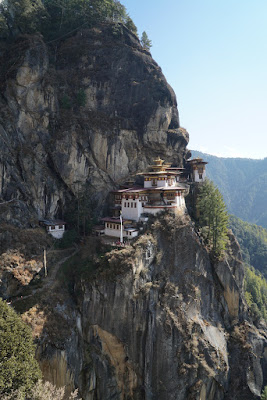Blessed Land
I'm sitting in the back of a taxi in a seemingly endless traffic jam, half choking on the exhaust fumes that blast in through the open window, half deaf from the non-stop honking of car/motorbike horns. Some of you will aleady divine from this that the calm cleanliness of Bhutan is now behind me and I'm back in India - this time Siliguri.
However this entry is still about Bhutan. The internet connections were at times too wobbly and the agenda often too full for me to really get much online of the many things I experienced. So today's post is about Buddhism in Bhutan.
I've travelled in many Buddhist countries before, yet in Bhutan the key role of Buddhism in governance, everyday life and values was more apparent than elsewhere.
Of course the role of Buddhism was partly clear due to the fact that my guide Namgay was there to enlighten me about Buddhist practices in the country. But the outward signs were pretty hard to miss too.
Flags are very visible in Bhutan - probably a legacy from Tibet. Flags with mantras written on them are hung especially over water and on hilltops - the idea being that the wind and/or water will carry the prayers onwards to bless all sentinent beings, who come into contact with afore mentioned wind and/or water.
The colour of the flags tells its own story. Multi-coloured flags are just your general sort of prayer and blessings, whereas if you see a whole cluster of tall flagpoles with only white prayer flags attached to them, this will be in memory of a dearly deceased.
At first I worried about the mortality rate in Bhutan, since every household seemed to have scores of white flags. But apparently each deceased gets ten or more flags raised in his/her memory. The exact number depends on the age of the deceased and an astrological consultation with the monks, who are the ones to define how many flags should be raised and where. The monks are kept busy also with naming children (people have no family names, only given names, which the parents get from the monastery), blessing houses annually in three day long ceremonies, consulting on which colours it would be auspicious to paint your home ... luckily the amount of monks is on the rise. It's a busy profession.
But people also take care of their soul on their own. Prayer wheels are everywhere and come in all sizes.
Reading prayers for the benefit of all beings (you can't be too selfish and just pray for yourself and your nearest and dearest) is a good way of ensuring a better spot in the rebirth of next life. However, reading mantras aloud is a rather slow and inefficient way compared to turning prayer wheels, since each prayer wheel has numerous, possibly thousands of mantras inside it. One turn equals reading all these mantras. A hint: The prayer wheel must always be turned clockwise by the way so that your good intentions don't go to waste!
Stupas, smallish hut or dome-like white structures with holy objects inside them, must always be circled in a clockwise direction to get the benefit of the mantras inside them - so you must always pass them from the left if you are in such a hurry, that you don't have time to go round the whole stupa. This is true also when driving as occasionally there will be a stupa by the road. Well, I should say in the middle of the road. The road then splits so that all cars can pass the stupa on the correct, left side. Thank god for left sided traffic in Bhutan, I say, since if people drove on the right side of the road, passing these stupas in the road would prove a logistical nightmare.
Buddhism in Bhutan is awfully pretty! Bhutanese dzong and monasteries are among the most beautiful buildings I have ever seen. Just check out these photos from the 17th Century courtyards ofParo dzong.
Or my very "own" Trongsa dzong
And the prize for best setting goes to the legendary Tiger's Nest monastery. The oldest part of Tiger's Nest dates to the 8th Century, and the "new" bits to the 17th Century. A truly beautiful setting, but a tough hike in the altitude. Also once you get to the top there are several altar rooms, all of which must be entered without shoes on. And let me tell you that walking with thin socks on frozen rock is hard on a long suffering Finn.
Now it's time to leave a fond farewell to Bhutan and Buddhism. I'll let this 51 metre tall bronze and copper Buddha do that for me. Om om om ommmm.




















Comments
MRL Promotions
back bar display stands